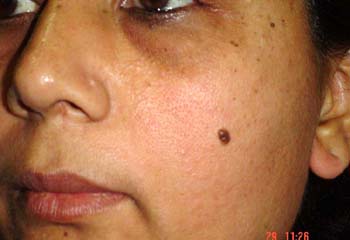Mole Removal Surgery
Moles, or nevi, are frequently removed for a variety of reasons. They can be removed by two surgical methods:
excision (cutting) followed by stitches andexcision with cauterization (a tool is used to burn away the mole).
Although laser removal has been tried for moles, it is not usually the method of choice for most deep moles because the laser light doesn't penetrate deeply enough.Typically, the doctor or dermatologist (a skin specialist) may choose excision with or without stitches, depending on the depth of the mole and the type of cosmetic outcome desired
What is a mole?
Many people refer to a mole as any dark spot or irregularity in the skin. Doctors use different terms. But skin marks such as these are not treated the same way moles are and are not discussed here:
excision (cutting) followed by stitches andexcision with cauterization (a tool is used to burn away the mole).
Although laser removal has been tried for moles, it is not usually the method of choice for most deep moles because the laser light doesn't penetrate deeply enough.Typically, the doctor or dermatologist (a skin specialist) may choose excision with or without stitches, depending on the depth of the mole and the type of cosmetic outcome desired
What is a mole?
Many people refer to a mole as any dark spot or irregularity in the skin. Doctors use different terms. But skin marks such as these are not treated the same way moles are and are not discussed here:
- birthmarks
- abnormal collections of blood vessels (hemangiomas)
- keratoses (benign or precancerous spots, which appear after about age 30 years)
- Some people are born with moles. Other moles appear over time.
- Sun exposure seems to play a role in the development of moles and may even play a role in the development of atypical, or dysplastic, moles.
- The role of heredity cannot be underemphasized. Many families have a type of mole known as dysplastic (atypical), which can be associated with a higher frequency of melanoma or skin cancer.
Mole Removal Preparation
The area to be treated will be cleansed. Depending on the surgeon's preferences, this will be done either with alcohol, Betadine, or another suitable material.
Then the area will be numbed with anesthetic, such as lidocaine (Anestacon, Bactine, LidaMantle, Lidocaine Viscous, Lidoderm, Medi-Quik Spray, Xylocaine Jelly, Xylocaine Topical, Xylocaine Viscous, Zilactin-L). This will not usually take much time to accomplish. Many surgeons prefer to wait after numbing to allow the blood flow to the area to diminish (sometimes up to 15 minutes). Interestingly, while most patients use the word Novocain (generic name: procaine) to describe the anesthesia used, this drug isn't used anymore in skin surgeries. There are some medications that can be used if patients are allergic to lidocaine. Additionally, most surgeons prefer to add epinephrine to the lidocaine in order to help stop any bleeding.
During the Procedure
Removal with simple cutting without stitches
The surgeon takes a scalpel and shaves the mole off flush or slightly below the level of skin.
Then, either an electrical instrument will cauterize or burn the area or a solution will be placed on the area to stop any bleeding.
- After this, a topical antibiotic is placed on the wound.
- The wound is then covered with a bandage.
- The doctor will give you instructions on how to take care of your wound. You are usually able to leave shortly after.
- Removal by cutting with stitches
- Moles removed by excision (cutting) with stitches are usually darker in color or flat moles, or both
- The surgeon maps out the mole and then sterilizes or cleans the area and numbs it.
- Then a scalpel is used to cut the mole and a border surrounding the mole. The border size depends on the concern of the surgeon about the possible chances of precancer or cancer for the mole being removed.
- Depending on the depth, stitches are placed either deep (these are absorbed by the body and do not have to be removed) or on the upper surface of the skin (these don't absorb and will be removed later).
After the Procedure
- After the procedure, you need to keep a layer of antibiotic salve and a bandage on the wound. Use an antibiotic ointment that does not include neomycin (Medi-Quik, Neosporin, triple antibiotic). Many people are allergic to neomycin and may develop a rash at the site. Polysporin is a brand that does not contain neomycin.
- Clean the wound once or twice daily with either water or diluted hydrogen peroxide.
- After cleaning the wound, apply the antibiotic salve and bandage.
- These steps are repeated until the wound is healed.
- Misconceptions about healing
- Some people think that wounds need to be open to the air and that this helps healing. Several studies have disproved this and found significantly quicker healing with bandages and antibiotic salve.
- Similarly, vitamin E has been found to slow healing rather than accelerate it, and scars were shown to be worse with vitamin E placed directly on wounds than without it.
- Neosporin is something that is commonly used over wounds, but this can often cause an allergic reaction. For this reason, we recommend the brand name Polysporin to our patients. If patients are allergic to this, studies have shown that simple Vaseline Petroleum Jelly is adequate in most cases.
- 2.
















0 comments:
Post a Comment